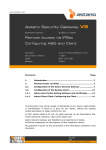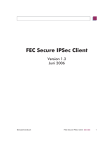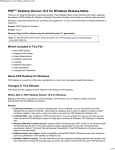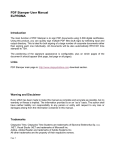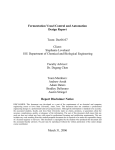Download Configuration Guide
Transcript
www.astaro.com Astaro Secure Client V9 Software version: 9.000 or higher Configuration Guide Astaro Security Gateway V7 Author: Richard Striegel Contact: [email protected] Document version: 1.000 Date: 2007-03-21 Status: Public Contents Page 1. Introduction........................................................................ 3 2. What is Astaro Secure Client? ............................................. 3 2.1. Getting Software, Configuration File and Certificate ........... 4 3. Installation ......................................................................... 5 3.1. System Requirements ......................................................... 5 3.2. Installation Instructions ..................................................... 5 4. Licensing and Importing Profiles ........................................ 8 5. Configuration of X.509 based Connections.........................10 5.1. X.509 Certificate when using PKCS#12..............................16 5.2. X.509 Certificate using Smart Cards or USB Tokens ...........16 6. Connecting and Disconnecting ...........................................19 7. Configuring Connections via X.509 Certificate ...................20 8. Configuration of the Astaro Security Gateway ...................23 8.1. X.509 Certificate Connections ............................................23 Guide EN www.astaro.com/kb Configuration Guide ASC V9 to ASG V7 This document may not be copied or distributed by any means, electronically or mechanically, in whole or in part, for any reason, without the express written permission of Astaro AG. © 2007 Astaro AG. All rights reserved. Amalienbadstraße 36/Bau 33a, 76227 Karlsruhe, Germany, http://www.astaro.com Astaro Security Gateway, Astaro Secure Client and WebAdmin are trademarks of Astaro AG. All further trademarks are the property of their respective owners. No guarantee is given for the correctness of the information contained in this document. Guide EN www.astaro.com/kb Configuration Guide ASC V9 to ASG V7 1. Introduction Congratulations on your purchase of the VPN IPSec client Astaro Secure Client V9, and welcome to the Astaro family. This guide gives you a tutorial on how to set up the Astaro Secure Client in order to use it as a IPSec VPN client with Astaro Security Gateway. The most recent version of this document is always available at the following address: http://www.astaro.com/kb In order to provide you with the most up-to-date information possible, this document makes occasional reference to other documents available at the web sites of Astaro and other organizations. Please note that these addresses may change over time, and that documents hosted by other organizations may even be removed entirely. If you have further questions, or notice any mistakes in this manual, please do not hesitate to contact us at [email protected] For further support, please visit our user support forum at http://www.astaro.org or make use of the Astaro Support Program: http://www.astaro.com/support 2. What is Astaro Secure Client? Astaro Secure Client is an IPSec VPN client which is interoperable with Astaro Security Gateway. IPSec allows you, to give individual hosts access to your network through an encrypted IPSec tunnel. The structure is described in the following chart. The Astaro User Portal of the remote Astaro Security Gateway offers the Astaro Secure Client software, the configuration files, the necessary keys. You should get the log-in data for the user portal of the remote Astaro Security Gateway from your system administrator. The most recent version of this Astaro Secure Client is also available at the following address: http://www.astaro.com/download/software © 2007 Astaro AG. Subject to change without notice. 3 of 30 Configuration Guide ASC V9 to ASG V7 2.1. Getting Software, Configuration File and Certificate The Astaro User Portal is available for the remote access user. You can use this portal to download guides and tools for the configuration of your client. Especially for the IPSec remote access based on authentication with X.509 certificate, the user portal offers the Astaro Secure Client software (see item 1), the configuration files (see item 2) and necessary keys (see item 3) and configuration guides (see item 4). You should get the following log-in data for the Astaro User Portal from your system administrator: IP address, user name and password. 1. Start your Browser and open the Astaro User Portal: Start your browser and enter the management address of the Astaro User Portal as follows: https://IP address (example: https://192.168.2.100). A security notice will appear. Accept the security notice by clicking OK (Mozilla Firefox) or Yes (Internet Explorer). 2. Log in to the Astaro UserPortal: Username: Your username, which you received from the administrator. Password: Your password, which you received from the administrator. Please note that passwords are case-sensitive! Click Login. 3. Load the tools for the IPSec Remote Access to your client: The IPSec VPN tab will contain the software, configuration files and keys for your client. The Astaro Secure Client runs on Microsoft Windows 98SE, ME, NT 4.0 Service Pack 5 (SP5), 2000 and XP. Start the download process by clicking on Download. Close the Astaro User Portal session by clicking on Logout. The rest of the configuration takes place on the Astaro Security Client. © 2007 Astaro AG. Subject to change without notice. 4 of 30 Configuration Guide ASC V9 to ASG V7 3. Installation 3.1. System Requirements The requirements for installing and using this IPSec VPN client are: Hardware • 64 MB RAM • 10 MB free disk space • Network adapter • Microsoft Windows 98SE/ME/NT 4.0 Service Pack 5 (SP5)/2000/XP/Vista 3.2. Installation Instructions What follows is a step-by-step guide to the installation process. Preperation Before installation, please make sure you have the following items ready: • The Astaro Secure Client software • The Activation Key and Serial Number provided by Astaro Attention: Don’t install Astaro Secure Client if you have still installed a different VPN client on your machine (e.g. Sentinel). Uninstall the previous VPN client first. If you have already installed the previous version of the Astaro Secure Client, during the installation process the software will detect the already installed version and ask you whether it shall be updated. The first part of the installation uses the Installation Menu to configure basic settings. The setup program will check the hardware of the system, and then install the necessary software on your PC. Unpack the installation package (for example by using WinZip), if you have received it as a .ZIP file. Open a file browser and go to the appropriate directory. Launch the file ASC_V9-0.exe from this directory. © 2007 Astaro AG. Subject to change without notice. 5 of 30 Configuration Guide ASC V9 to ASG V7 Pick the installation language of your choice and press OK. You should see the installation wizard now. Click on Next to proceed. You will see the software license. If you agree to the terms of the license, click on Yes. © 2007 Astaro AG. Subject to change without notice. 6 of 30 Configuration Guide ASC V9 to ASG V7 As installation method, choose Typical. Click on Next to proceed. Then the installation process will be started. The installation wizard will copy the necessary files on your system. A virtual network card will be installed during the installation process. Since the relevant driver is not certified by Microsoft, a corresponding caution message will appear during the installation process. You can ignore this message. Click on Continue Anyway. © 2007 Astaro AG. Subject to change without notice. 7 of 30 Configuration Guide ASC V9 to ASG V7 When installation process is finished, you are asked to reboot your computer. Click on Finish. 4. Licensing and Importing Profiles Through the Profile Import (1) function the profile settings of the INI-file can be automatically imported by the Astaro Secure Client. The INI-file can either be created by the destination system with an appropriate export function or be edited manually. The Import_d.txt and Import_e.txt example files for the manual creation can be found in the installation folder of the client. You have the choice to enter a license key (2) for the software (“Install as an Authorized Licensed Version”) or to use the client on trial (“Install as 30 day Test Version”). You can enter the license key at a later time. Activating and/or Licensing of the software is described in the user manual of the Astaro Secure Client V9 in chapter 4.6.2. © 2007 Astaro AG. Subject to change without notice. 8 of 30 Configuration Guide ASC V9 to ASG V7 Configuring Astaro Secure Client using the Profile Import function: For Road Warrior tunnels between Astaro Secure Client and Astaro Security Gateway the Profile Import function may be used when the connection to the X.509 certificates is setup. In this case, first configure the settings on the Astaro Security Gateway security system. The settings for a connection with X.509 certificates are described in chapter 8.1 on page 23. Note: For IPSec connections with X.509 certificates, make sure that the CA certificate which issued the remote endpoint's certificate is stored on the CA Management page. In order to set up the Astaro Secure Client, the following steps need to be performed: 1. Import the User’s Configuration File. Start the profile import wizard by clicking Configuration/Profile Import. The Astaro User Portal of the remote Astaro Security Gateway offers the configuration files and the necessary keys. You should get the log-in data for the appropriate user portal from your system administrator. Getting the configuration file and the necessary keys is described in chapter 2.1 on page 4. Store the profile (*.ini file) and close afterwards the profile import wizard by clicking OK. 2. Import the PKCS#12 file. Importing the PKCS#12 file is described in chapter 5.1 on page 16. Store the key by clicking OK. 3. Establish a road warrior connection between the client and the destination system. Establishing a connection between the client and a destination system is described in chapter 6 on page 19. © 2007 Astaro AG. Subject to change without notice. 9 of 30 Configuration Guide ASC V9 to ASG V7 5. Configuration of X.509 based Connections This chapter describes how to set up a road warrior connection which uses X.509 certificates as authentication method. 1. Start the Configuration Assistant: When Astaro Secure Client starts after the reboot, it will automatically ask you whether you want to set up a new connection. Click on Yes. 2. Choose the Connection Type: The configuration wizard starts and asks you for the type of connection you want to create. Select Link to Corporate Network using IPSec and click on Next. 3. Define the Connection Name: As next step you are asked to enter a name for the connection. Pick a name of you choice and click on Next. © 2007 Astaro AG. Subject to change without notice. 10 of 30 Configuration Guide ASC V9 to ASG V7 4. Choose the Link Type: Astaro Secure Client offers the possibility to control your dial-up devices, like modem or DSL. However, this is not mandatory. You can use the internal Microsoft Windows dialer instead. Therefore normally you just choose LAN (over IP) as Communication Media in this dialog. Click on Next. 5. Define the VPN Gateway Parameters: You are now asked to enter the address of the VPN gateway, i.e. your Astaro Security Gateway machine. If you have a DNS record for the gateway, then you can enter the DNS name here. Otherwise simply enter the IP address of the gateway. Do not enable the option Use extended authentication (XAUTH), since ASG does not support it. Click on Next. 6. Configure the Basic IPSec Parameters: In the next step you are asked for the basic IPSec parameters. Set the PFS group, as you configured it on Astaro Security Gateway (in WebAdmin: Remote Access >> IPSec >> Policies - the policy used in your road warrior connection definition), then click on Next. Exchange mode: Select Main Mode. The Aggressive Mode option is not supported by Astaro Security Gateway. © 2007 Astaro AG. Subject to change without notice. 11 of 30 Configuration Guide ASC V9 to ASG V7 PFS group: Set the PFS group, as specified on Astaro Security Gateway. Use IP compression: The data can be compressed in order to increase transmission rates. Click on Next. 7. Set the VPN ID: In this window, leave the two Pre-shared key fields empty, since you want to use X.509 authentication. Select the correct VPN ID of the user, as specified on Astaro Security Gateway (in WebAdmin: User in Remote Access >> IPSec >> Connections). Depending on the VPN ID type, you need to enter the following information in the ID field: Depending on the configuration on Astaro Security Gateway, you need to execute the following settings: | Pre-shared key Shared secret: Leave this field empty. Confirm secret: Leave this field empty. | Local identify The settings for the local identify must be aligned with the settings on the Astaro Security Gateway (ASG). The following settings can be made. The possible settings in the WebAdmin configuration tool are … IP Address: leave input field empty. Fully Qualified Domain Name: enter the host name (FQDN) of the client, as defined in Astaro Security Gateway. Example: host.company.org Fully Qualified Username: enter the e-mail address (USER_FQDN) of the client, as defined in Astaro Security Gateway. Example: [email protected] On the ASG this corresponds to the E-Mail Address setting. ASN1 Distinguished Name: leave input field empty. On the ASG this corresponds to the Distinguished Name (DER_ASN1_DN) setting. © 2007 Astaro AG. Subject to change without notice. 12 of 30 Configuration Guide ASC V9 to ASG V7 All other identifier types are not available on Astaro Security Gateway. Type: Choose the VPN ID. ID: Enter the VPN ID, if you have selected Fully Qualified Domain Name (e.g. host.company.org) or Fully Qualified Username (e.g., [email protected]). Otherwise leave the field empty. Click on Next. 8. Assign the IP Address to the Client: Now, you are asked to enter the IP address configuration of the connection. IP address assignment: For an IPSec VPN connection to Astaro Security Gateway V7 set this option to Use local IP address. DNS server: Enter the IP address of your DNS server, if desired. WINS server: Enter the IP address of your WINS server, if desired. Click on Next to proceed. 9. Configure the Firewall Features: The last step of the wizard is to specify the personal firewall settings. It is recommended to enable the firewall when connected and to deny split tunneling with the option Only communication within the tunnel permitted. Depending on your security policy, you can configure different settings here, of course. Enable Stateful Inspection: With this option you can specify whether the personal firewall should be disabled (off), enabled at all times (always) or only enabled when connected to the VPN gateway (when connected). © 2007 Astaro AG. Subject to change without notice. 13 of 30 Configuration Guide ASC V9 to ASG V7 Only communication within the tunnel permitted: This option denies the possibility of split tunneling. If it is enabled, then the client blocks all other traffic to the Internet, as soon as the VPN connection is established. Enable NetBIOS over IP: Enable this option to allow NetBIOS traffic to traverse through the tunnel. Click on Finish to complete the wizard. 10. Edit the Connection: In order to complete the configuration, edit the connection in the Profile Settings window that appears next. Double-click on your newly created entry, or alternatively select the entry and click on Configure. 11. Define the Remote Networks: Click on the section Remote Networks. On the right side, you can enter one or more remote networks, depending on your connection definition on Astaro Security Gateway (ASG) (specified as Local subnet on ASG). Leave the unused entries as empty. If the VPN subnet is set to Any on ASG, then you can simply leave the setting of this category as it is. Networks are defined via a separate entry window. Click on the New button to enter a new network. Enter the IP address and network mask into the entry window and confirm your settings by clicking on OK. Note: In order to use multiple remote subnets, you have to define multiple IPSec VPN connections on ASG with the same policy and the same remote key(s), each connection with a different subnet. On the client you can simply add these different subnets in this window. When connecting, all tunnels are established to the subnets automatically. © 2007 Astaro AG. Subject to change without notice. 14 of 30 Configuration Guide ASC V9 to ASG V7 You should now be ready to establish the VPN connection. Click on OK to close the window, and again OK to close the profile overview window. See chapter 6 in order to find out how to connect to the VPN. © 2007 Astaro AG. Subject to change without notice. 15 of 30 Configuration Guide ASC V9 to ASG V7 5.1. X.509 Certificate when using PKCS#12 Open the menu Configuration >> Certificates on Astaro Secure Client. As Certificate, select from PKCS#12 File. Then click on the button next to PKCS#12 Filename. Browse for the PKCS#12 file of the user and select it. Then click on OK to close the window. Note: The user’s PKCS#12 file is downloaded from Astaro Security Gateway on the Remote Access >> Certificate Management >> Certificates tab. You should now be ready to establish the VPN connection. Click on OK to close the window. See chapter 6 in order to find out how to connect to the VPN. 5.2. X.509 Certificate using Smart Cards or USB Tokens Open the menu Configuration >> Certificates on the Astaro Secure Client. As Certificate, select PKCS#11 Module. Then click on the button next to PKCS#11 Module. The PKCS#11 module wizard appears. Click on Next to start the process. The wizard automatically searches PKCS#11 modules on your system. © 2007 Astaro AG. Subject to change without notice. for existing 16 of 30 Configuration Guide ASC V9 to ASG V7 1. Select the PKCS#11 Module: Choose an offered DLL and click Next to proceed. Note: If using SafeNet tokens, you may be presented with several choices. Please select dkck232.dll in this case. 2. Select the PKCS#11 Slot: Select the correct hardware device, which is usually the first one in the list, and click on Next. 3. Select the Certificate: The wizard will show the existing key/certificate pairs on the token or Smart Card. Select the right certificate and click on Next. © 2007 Astaro AG. Subject to change without notice. 17 of 30 Configuration Guide ASC V9 to ASG V7 4. Finish PKCS#11 Module Configuration: After selecting the certificate, the certificate configuration window will appear again. You should now be ready to establish the VPN connection. Click on OK to close the window. See chapter 6 in order to find out how to connect to the VPN. Note: Some vendors fail to import the CA certificate from the PKCS#12 container to the token or Smart Card. In this case, Astaro Secure Client can not retrieve the CA certificate from the token or Smart Card. You can recognize this error case by checking Log >> Logbook: it reports PKI ERROR: - Client Error: Verify Certificate with error 2002 ! In order to resolve this issue, obtain the CA certificate in PEM format and copy it to %SYSTEMROOT%\ncple\CaCerts\, for example C:\WINDOWS\ncple\CaCerts\. On Astaro Security Gateway, you can download the CA certificate in Remote Access >> Certificate Management >> Certificate Authority tab. Note: If you use an Aladdin eToken, and you get an error message Can’t open PKCS#11 session, then the PIN of your token or Smart Card is not set properly. To resolve this issue, set the token’s or Smart Card’s PIN anew with the vendor’s software. © 2007 Astaro AG. Subject to change without notice. 18 of 30 Configuration Guide ASC V9 to ASG V7 6. Connecting and Disconnecting This chapter describes how to establish a road warrior connection between the client and Astaro Security Gateway. Note: Depending on your policy definition on Astaro Security Gateway, the automatic negotiation of IPSec parameters and encryption algorithms may fail. In this case, see Appendix A in order to find out how to manually set up the policy in Astaro Secure Client. Click on Connect. If the connection establishes successfully, you will see a green bar and the information Connection is established, as can be seen in the screenshot. If you chose X.509 as authentication method, a PIN dialog will show when connecting to the VPN. Enter the password of the PKCS#12 container in this case. Astaro Secure Client has a caching mechanism. So during normal operation (connect/disconnect) it is only necessary to enter the PIN once. It is only after a restart of your computer that you need to enter the PIN again. The client has a timeout mechanism included. By default, Astaro Secure Client closes the VPN connection after 100 seconds of inactivity. In order to increase this value, edit your profile in Configuration >> Profile Settings and go to the section Line Management. You can specify a higher value in Inactivity Timeout, or set the value to 0 in order to disable the timeout mechanism completely. To disconnect from the VPN, click on Disconnect. Alternatively, you can connect and disconnect from the Astaro Secure Client tray icon menu. Click on the icon with the right mouse button, and you will see the context menu. If the connection is established successfully, you can see the tray icon switching from red to green, as can be seen in right screenshot. © 2007 Astaro AG. Subject to change without notice. 19 of 30 Configuration Guide ASC V9 to ASG V7 7. Configuring Connections via X.509 Certificate This chapter describes the settings on the Astaro Secure Client for the IPSec connection with X.509 certificates. Note that these manual settings may also be made automatically by importing the User Config file. This process is described in more detail in chapter 8.1 on page 23. Security Note: The connection type with Pre-Shared Keys (PSK) is in general not recommended. If you use PSKs for the IPSec VPN connection between the Astaro Secure Client and the Astaro Security Gateway security system, a packet filter rule with the setting Source: Any must be defined! If possible, use the connection type with X.509 certificates for a secure IPSec VPN connection. 1. Open the Profile Settings Window: Edit your profile in Configuration Æ Profile Settings. You need to set the IPSec policy to the same values as specified on Astaro Security Gateway (ASG). Click on the section IPSec General Settings. There are three items which you need to change: Policy lifetimes, IKE policy and IPSec policy. First click on Policy lifetimes. Set the lifetime values to the same values as on Astaro Security Gateway security system. | IKE policy Duration: Set this to the same value as on ASG - ISAKMP (IKE) Settings/SA Lifetime. | IPSec policy Duration: Set this to the same value as on ASG - IPSec Settings/SA Lifetime. Close the window by clicking on OK. © 2007 Astaro AG. Subject to change without notice. 20 of 30 Configuration Guide ASC V9 to ASG V7 2. Edit the IKE Policy: Now, you are back at the Profile Settings window. Click on Policy editor. This opens the left window. In the policy tree, click on IKE Policy and on IPSec Policy to open the tree view. Click on IKE Policy, then on the New Entry button. This opens the following dialog. Define a new IKE policy and specify the values as defined on ASG. Name: Enter a name for the policy. Authentication: Select RSA-Signature. Encryption: Select the value that is specified in the ASG policy - ISAKMP (IKE) Settings/ Encryption Algorithm. Hash: Select the value that is specified in the ASG policy - ISAKMP (IKE) Settings/Authentication Algorithm. © 2007 Astaro AG. Subject to change without notice. 21 of 30 Configuration Guide ASC V9 to ASG V7 DH Group: Select the value that is specified in the ASG policy - ISAKMP (IKE) Settings/IKE DH Group. Click on OK to close the window. 3. Edit the IPSec Policy: Now, you are back at the IPSec Configuration window. In the policy tree, click on IPSec Policy, then on New Entry. This opens the following dialogue. Define a new IPSec policy and specify the values as defined on ASG. Name: Enter a name for the policy. Transform: Select the value that is specified in the ASG policy - IPSec Settings/Encryption Algorithm. Authentication: Select the value that is specified in the ASG policy - IPSec Settings/Authentication Algorithm. Click on OK to close the window. 4. Select the Policy: You are now back at the Profile Settings window. Select your newly defined policy as IKE policy and IPSec policy. Then click on OK to close the window. The settings for the IPSec connection with X.509 certificates are now completed. Now make the settings on the Astaro Security Gateway security system. Then you can establish the IPSec tunnel as described in chapter 6. © 2007 Astaro AG. Subject to change without notice. 22 of 30 Configuration Guide ASC V9 to ASG V7 8. Configuration of the Astaro Security Gateway The Astaro Security Gateway configuration will use the WebAdmin interface, accessed through a standard web browser (e.g., MS Internet Explorer) from your administration PC. The process of starting the WebAdmin interface is described in the Astaro Security Gateway user manual in the introduction of chapter 5. 8.1. X.509 Certificate Connections The Astaro Security Gateway is configured via the web based WebAdmin configuration tool from the administration PC. Opening and using this configuration tool is extensively described in the Astaro Security Gateway V7 administration guide. 1. Define the user account for the remote host: Open the Users >> Users page. Define a new user account for the remote client. With remote access via IPSec this user account is necessary for accessing the Astaro User Portal and for VPN. Make the following settings: Username: Enter a specific user name (e.g. gforeman). In doing so remember that the remote user will need this username later to log in to the Astaro User Portal. Real name: Enter the full name of the remote user (e.g. George Foreman). Email address: Enter the e-mail address of the user. When you specify an e-mail address, an X.509 certificate for this user will be generated automatically while creating the user account, using the e-mail address as the certificate's VPN ID. The certificate will be displayed on the Remote Access >> Certificate Management >> Certificates tab. Authentication: With the Local authentication method the following two entry menus will be displayed for the definition of the password. Password: Enter the password for the user. In doing so remember that also the remote user will need this password later to log in to the Astaro User Portal. Repeat: Confirm the password. © 2007 Astaro AG. Subject to change without notice. 23 of 30 Configuration Guide ASC V9 to ASG V7 Use static remote access IP: Each remote access user can be assigned to a specific IP address. The assigned IP address must not originate from the IP address pool. During the dial-up the address is automatically assigned to the host. Enter the static IP address in the RAS address box. Comment (optional): Enter a description or additional information on the user. Save your settings by clicking on Save. More detailed information on the configuration of a User Account and detailed explanations of the individual settings can be found in the Astaro Security Gateway V7 administration guide in chapter 5. 2. Configure the IPSec remote access: Open the Remote Access >> IPSec page. On the Connections tab, click New IPSec remote access rule. The Add IPSec remote access rule dialog box opens. More detailed information on the configuration of a IPSec Remote Access and detailed explanations of the individual settings can be found in the Astaro Security Gateway V7 administration guide in chapter 13. Name: Enter a descriptive name for this connection. Interface: Select the network interface to use for IPSec access. Local networks: Select the local networks that should be reachable to the client. © 2007 Astaro AG. Subject to change without notice. 24 of 30 Configuration Guide ASC V9 to ASG V7 Note: If you wish the IPSec-connected users to be allowed to access the Internet, you need to select Any in the Local networks dialog box. Additionally, you need to define appropriate Masquerading or NAT rules. Policy: Select an already defined policy (in this example: AES-256). Now you can use the Remote Access >> IPSec >> Policies tab to define your own policies. Creating of own IPSec Policies is described in in the administration guide in chapter 13. Authentication type: IPSec remote access supports authentication based on CA DN Match, Preshared Keys and X.509 Certificate. The settings in this section depend on the authentication type: | CA DN Match The authentication is based on the Distinguished Name (DN). Authority: Select the Certificate Authority VPN Signing CA for the VPN users. DN mask: In order to use a Distinguished Name as an ID, you will need information from the X.509 index. Possible indications are Country (C), State (ST), Local (L), Organization (O), Unit (OU), Common Name (CN) and E-Mail Address (E). IP Pool: The default settings assign addresses from the private IP space 10.242.4.x/24. This network is called the VPN Pool (IPSec). If you wish to use a different network, simply change the definition of the VPN Pool (IPSec) on the Definitions >> Networks page. | Preshared Keys Preshared Key: Enter the shared secret. This shared secret is a secure phrase or password that is used to encrypt the traffic using the encryption algorithm for IPSec. Confirm: Confirm the shared secret. Security Note: Use a secure password! Your name spelled backwards is, for example, not a secure password – while something like xfT35!4z would be. Ensure that this password does not fall into the hands of unauthorized third parties. With this password, an attacker can build a connection to the internal network. We recommend changing this password at regular intervals. © 2007 Astaro AG. Subject to change without notice. 25 of 30 Configuration Guide ASC V9 to ASG V7 | X.509 Certificate If you choose X.509 CA certificate, the following dialog box will be displayed. Allowed users: Select the user object, which had been created automatically in step 1 (e.g. gforeman). Automatic packet filter rules: Once the IPSec VPN tunnel is successfully established, the packet filter rules for the data traffic will automatically be added. After the completion of the connection, the packet filter rules will be removed. Comment: Add a description or other information about the IPSec connection. Save your settings by clicking on Save. 3. Configure the advanced IPSec remote access settings: Open the Remote Access >> IPSec >> Advanced tab. | Local X509 certificate Select the local X.509 certificate used for IPSec connections to authenticate the server. © 2007 Astaro AG. Subject to change without notice. 26 of 30 Configuration Guide ASC V9 to ASG V7 | Dead Peer Detection (DPD) The Dead Peer Detection option is used to automatically determine whether a remote IPSec peer can still be reached. Usually it is safe to always enable this option. The IPSec peers automatically determine whether the remote side supports Dead Peer Detection or not, and will fall back to normal mode if necessary. | CRL handling Automatic fetching: There might be situations, in which the provider of a certificate attempts to revoke the confirmation awarded with still valid certificates, for example if it has become known that the receiver of the certificate fraudulently obtained it by using wrong data (name, etc.) or because an attacker has got hold of the private key, which is part of the certified public key. For this purpose, so-called Certificate Revocation Lists or CRLs are used. They normally contain the serial numbers of those certificates of a certifying instance, that have been held invalid before their expiration. The Automatic Fetching option automatically requests the CRL through the URL defined in the partner certificate via HTTP, Anonymous FTP or LDAP Version 3. On request, the CRL can be downloaded, saved and updated, once the validity period has expired. Strict policy: Any partner certificate without a corresponding CRL will be rejected. | Misc settings Copy TOS (Type of Service) value: Type-of-Service-Bits are several four Bit-flags in the IP header. The Bits are referred to as Type-of-Service-Bits, as they allow the transferring application, to tell the network which type of service quality is necessary. The available service quality classes are: minimum delay, maximum throughput, maximum reliability and minimum cost. This option copies the content of the TOS field in the encrypted data packet, so that the IPSec data traffic can be routed according to its priority. Allow path MTU discovery: It is usually preferable that IP data packets be of the largest size that does not require fragmentation anywhere along the path from the source to the destination. This size of the data packet is referred to as the Path Maximum Transmission Unit (PMTU). If any of the data packets are too large to be forwarded without fragmentation by some router along the path, that router will discard them and return ICMP Destination Unreachable messages with a code meaning "fragmentation needed and DF set". Upon receipt of such a message, the source host reduces its assumed PMTU for the path. MTU: In this field you can specify the Maximum Transmission Unit (MTU) of the IPSec interface; the default MTU is 1420 byte. © 2007 Astaro AG. Subject to change without notice. 27 of 30 Configuration Guide ASC V9 to ASG V7 4. Configure the advanced remote access settings: Open the Remote Access >> Advanced page. This page allows you to define name servers (DNS and WINS) and the name service domain, which should be assigned to hosts during the connection establishment. 5. Define the packet filter rule: Only for authentication based on X.509 certificate, you needn’t define this packet filter rule if you have enabled the Automatic packet filter rule function during the configuration of the IPSec remote access in step 2. Open the Network Security >> Packet Filter >> Rules tab. After clicking on the New rule button the dialog box for new rules will appear. Create a new rule for the access to the local internal network. Source: Remote host or user (in this example: gforeman). Service: Set the service. Destination: The allowed internal network (in this example: Internal (Network)). Action: Allow. Confirm your settings by clicking on Save. New rules will be added at the end of the list and remain disabled (status light shows red) until they are explicitly enabled by clicking on the status light. Active rules are processed in the order of the numbers (next to the status light) until the first matching rule. Then the following rules will be ignored! The sequence of the rules is © 2007 Astaro AG. Subject to change without notice. 28 of 30 Configuration Guide ASC V9 to ASG V7 thus very important. Therefore never place a rule such as Any – Any – Any – Allow at the beginning of the rules since all traffic will be allowed through and the following rules ignored! More detailed information on the definition of Packet Filter Rules and detailed explanations of the individual settings can be found in the Astaro Security Gateway V7 administration guide in chapter 7. 6. Define the masquerading rule (optional): Masquerading is used to mask the IP addresses of one network (in this example: gforeman) with the IP address of a second network (in this example: External). Thus remote users, who have only private IP addresses can surf on the Internet with an official IP address. More detailed information on the definition of Masquerading Rules and detailed explanations of the individual settings can be found in the Astaro Security Gateway V7 administration guide in chapter 7. Open the Network Security >> NAT >> Masquerading tab. Make the following settings: Network: Select the network of the remote endpoint (in this example: gforeman). Interface: Select the interface that shall be used to mask the clients. (in this example: External). Confirm your settings by clicking on Save. New masquerading rules will be added at the end of the list and remain disabled (status light shows red) until they are explicitly enabled by clicking on the status light. © 2007 Astaro AG. Subject to change without notice. 29 of 30 Configuration Guide ASC V9 to ASG V7 7. Activate the proxies (optional): If the remote employees shall access URL services via the remote access you may configure the required proxies on the Astaro Security Gateway – this would be the DNS and HTTP proxy for example. More detailed information on the configuration of Proxies and detailed explanations of the individual settings can be found in the Astaro Security Gateway V7 administration guide. After configuring the VPN server (Headquarters) you must configure the road warrior. Depending on the security policy of your organization and the requirements of your network you might have to make additional settings. © 2007 Astaro AG. Subject to change without notice. 30 of 30































